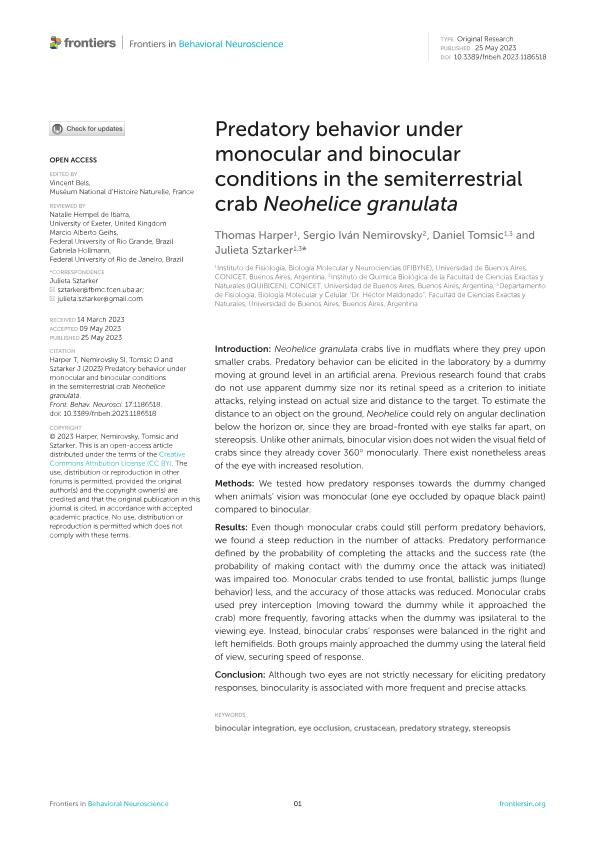Artículo
Predatory behavior under monocular and binocular conditions in the semiterrestrial crab Neohelice granulata
Fecha de publicación:
05/2023
Editorial:
Frontiers Media
Revista:
Frontiers in Behavioral Neuroscience
ISSN:
1662-5153
Idioma:
Inglés
Tipo de recurso:
Artículo publicado
Clasificación temática:
Resumen
Introduction: Neohelice granulata crabs live in mudflats where they prey upon smaller crabs. Predatory behavior can be elicited in the laboratory by a dummy moving at ground level in an artificial arena. Previous research found that crabs do not use apparent dummy size nor its retinal speed as a criterion to initiate attacks, relying instead on actual size and distance to the target. To estimate the distance to an object on the ground, Neohelice could rely on angular declination below the horizon or, since they are broad-fronted with eye stalks far apart, on stereopsis. Unlike other animals, binocular vision does not widen the visual field of crabs since they already cover 360° monocularly. There exist nonetheless areas of the eye with increased resolution. Methods: We tested how predatory responses towards the dummy changed when animals’ vision was monocular (one eye occluded by opaque black paint) compared to binocular. Results: Even though monocular crabs could still perform predatory behaviors, we found a steep reduction in the number of attacks. Predatory performance defined by the probability of completing the attacks and the success rate (the probability of making contact with the dummy once the attack was initiated) was impaired too. Monocular crabs tended to use frontal, ballistic jumps (lunge behavior) less, and the accuracy of those attacks was reduced. Monocular crabs used prey interception (moving toward the dummy while it approached the crab) more frequently, favoring attacks when the dummy was ipsilateral to the viewing eye. Instead, binocular crabs’ responses were balanced in the right and left hemifields. Both groups mainly approached the dummy using the lateral field of view, securing speed of response. Conclusion: Although two eyes are not strictly necessary for eliciting predatory responses, binocularity is associated with more frequent and precise attacks.
Palabras clave:
BINOCULAR INTEGRATION
,
CRUSTACEAN
,
EYE OCCLUSION
,
PREDATORY STRATEGY
,
STEREOPSIS
Archivos asociados
Licencia
Identificadores
Colecciones
Articulos(IFIBYNE)
Articulos de INST.DE FISIOL., BIOL.MOLECULAR Y NEUROCIENCIAS
Articulos de INST.DE FISIOL., BIOL.MOLECULAR Y NEUROCIENCIAS
Articulos(IQUIBICEN)
Articulos de INSTITUTO DE QUIMICA BIOLOGICA DE LA FACULTAD DE CS. EXACTAS Y NATURALES
Articulos de INSTITUTO DE QUIMICA BIOLOGICA DE LA FACULTAD DE CS. EXACTAS Y NATURALES
Citación
Harper, Thomas; Nemirovsky, Sergio Ivan; Tomsic, Daniel; Sztarker, Julieta; Predatory behavior under monocular and binocular conditions in the semiterrestrial crab Neohelice granulata; Frontiers Media; Frontiers in Behavioral Neuroscience; 17; 5-2023; 1-11
Compartir
Altmétricas




